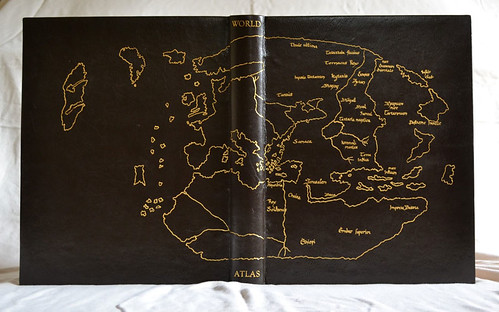
PREV ARTICLE
NEXT ARTICLE
FULL ISSUE
PREV FULL ISSUE
MICHAEL GREER: BOOKBINDING IN THE DIGITAL AGE
Here's a refreshing interview for bibliophiles from the BoingBoing blog. Avi Solomon interviews bookbinder Michael Greer.
-Editor

Avi
Michael
Just before my wife and I started packing to leave, I brought one last project to the binder. I had put together a bunch of essays and travel articles that I’d written and formatted into a proper book. I made seven copies and brought them to the binder. A week or so later I went to pick them up. By this time I was an established client so he really made them nice…all kinds of beautiful marbled papers and nice leathers. It was one thing to have another author’s book rebound, but seeing your own in full leather…well, I was hooked. School was out so I was there at an unusual time (for me) and as I was talking to the old man who owned the shop I heard a loud pounding from behind the wall. “What’s that?” I asked. “The binder,” he said. I’d always thought he was the binder, so it kind of took me by surprise. Turns out that the actual binder worked in the basement. I’d never seen him. I asked the owner if I could come watch him work one day. The next week my wife and I showed up. The binder hadn’t been told we were coming and seemed a little at a loss at first. I asked a question, my wife translated, and he would give one or two word replies. After a few of these exchanges he got up and reached behind a bunch of old rags and pulled out an old book. For the rest of the day, he showed us the way a book was made. He also told stories about the shop and it came out he would be retiring and the shop would probably close. It was hard news. The end of something special. That afternoon as my wife and I walked to the train, I told her I wanted to learn bookbinding and that’s what happened. After the summer, I worked at the shop for free and learned by watching and then by doing. It was one of the best experiences of my life.
Avi
Michael
With so much thread in the book, it’s fatter in back than in front, so to correct for this, the spine is glued up and rounded to take up some of the swell. After that, the book is put into a press and the spine is hammered so that the signatures bend over creating little shoulders. Essentially, you’re creating an arch. The boards act as columns. The arch of the spine works to fight gravity and keep the pages from sagging too much on the shelves. While the glue is drying you prepare the boards. Heavy carton is cut to size and lined with newspaper on the inside which makes them warp and sort of hug the text block. It looks awful. These boards get sanded and then attached to the text block with the cords. Meanwhile, the leather is cut out. In Morocco, we had a great machine that tapered off the leather so that it would fold over the edges better, but now I do all that work by hand. The leather is pasted up and then sort of molded onto the back of the book and then the front and back covers. It’s tricky getting it folded over at the top and bottom of the spine and bookbinders pride themselves on the shape they give to these “endcaps.” The pull of the leather counteracts the pull of the newsprint and the boards end up flat. The final task is the finishing…putting on the title with gold foil. It’s the hardest part of the job and the most stressful. You’ve got a pallet full of hot letters and one chance to place them squarely onto the back of a curved spine. I usually feel pretty awful about a book until it finally gets covered in leather. They just look so bad. But then my spirits lift and once the gold lettering is on, I’m usually feeling pretty happy again. It’s like alchemy.
Avi
Michael
To read the complete article, see:
Bookbinding in the Digital Age: an interview with Michael Greer
(boingboing.net/2011/10/16/bookbinding-in-the-digital The Numismatic Bibliomania Society is a non-profit organization promoting numismatic literature. See our web site at coinbooks.org. To submit items for publication in The E-Sylum, write to the Editor at this address: whomren@gmail.com To subscribe go to: https://my.binhost.com/lists/listinfo/esylum All Rights Reserved. NBS Home Page Contact the NBS webmaster 
|